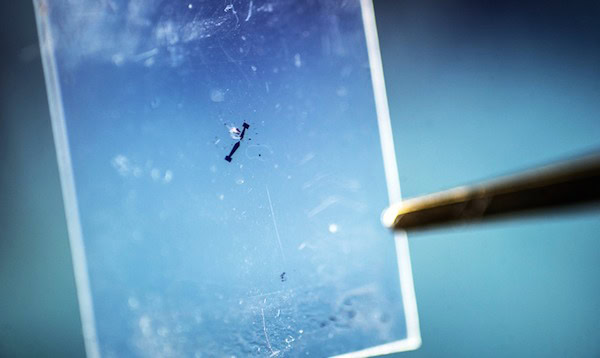
[Image above] This tiny piece of molybdenum disulfide could provide the basis for electric generators and mechanosensors of the future. Credit: Rob Felt; Georgia Tech
Isn’t it invigorating when you’re right?
I speak from experience, because just this week I was so right in a factual discord with my husband that I shall be awarded one victorious breakfast in bed this upcoming weekend. (Sorry, Tim, to rub it in once again that I WAS RIGHT. Whoops—caps lock is a bit sticky.)
Researchers from Columbia University and Georgia Institute of Technology might still be fist-pumping at how they right they were, too, about some interesting properties of thin molybdenum disulfide that aren’t present in the bulk material.
Their research, recently published in Nature, shows that atomically thin MoS2, but not bulk MoS2, exhibits piezoelectric properties—a characteristic that has been theorized, but remained experimentally unobserved, for atomically thin materials.
“Proof of the piezoelectric effect and piezotronic effect adds new functionalities to these two-dimensional materials,” sys Zhong Lin Wang, materials science professor and research co-leader, in a Georgia Tech press release. “The materials community is excited about molybdenum disulfide, and demonstrating the piezoelectric effect in it adds a new facet to the material.”

A tiny flake of molybdenum disulfide on a flexible plastic substrate. Credit: Rob Felt; Georgia Tech
MoS2 is highly polar, so the material’s number of layers greatly affects its properties—an even number of layers cancel out MoS2’s piezoelectricity, but an odd number of layers allow it to emerge. Crystalline orientation is also key for this material’s properties, according to the release.
To test the conversion of mechanical to electrical energy, the research team put thin MoS2 flakes on bendable plastic for testing. After optically determining the crystal orientation, they patterned metal electrodes on the flakes to measure electrical energy output.
As the scientists bent MoS2 that contained odd numbers of layers, the material generated electricity that changed sign with the direction of deformation—but even-numbered-layered MoS2 did not.
For all of you that like the technical details, the paper’s abstract provides some numbers: “A single monolayer flake strained by 0.53% generates a peak output of 15 mV and 20 pA, corresponding to a power density of 2 mW m−2 and a 5.08% mechanical-to-electrical energy conversion efficiency.”

Positive and negative polarized charges are squeezed from a single layer of atoms as it is being stretched. Credit: Lei Wang; Columbia Engineering
What’s more is that MoS2 is just one of the family of transition metal dichalcogenides, all of which are predicted to have similar properties.
“What’s really interesting is we’ve now found that a material like MoS2, which is not piezoelectric in bulk form, can become piezoelectric when it is thinned down to a single atomic layer,” says Lei Wang in the release.
“With what we’re learning, we’re eager to build useful devices for all kinds of applications,” adds research co-leader and mechanical engineering professor James Hone. “This material—just a single layer of atoms—could be made as a wearable device, perhaps integrated into clothing, to convert energy from your body movement to electricity and power wearable sensors or medical devices, or perhaps supply enough energy to charge your cell phone in your pocket.”
The paper is “Piezoelectricity of single-atomic-layer MoS2 for energy conversion and piezotronics” (DOI: 10.1038/nature13792).
Author
April Gocha
CTT Categories
- Electronics
- Energy
- Material Innovations
- Nanomaterials



